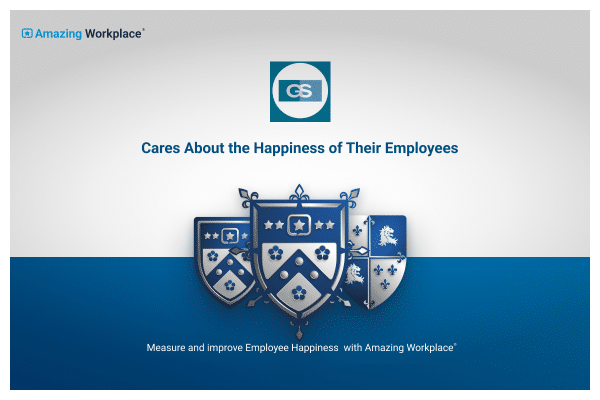Interior Design Elements in the Workplace
The design of a workplace and all the functional elements within it can greatly improve productivity.

There is no denying the shift in popularity towards remote work has changed the traditional idea of clocking in at the office, shutting yourself off in a stuffy cubicle, and staying there all day ignoring your co-workers. The rise in hybrid, flexible working conditions have transformed the landscape of the modern workspace. However, operating a business from a physical location still has many inherent benefits.
In an office you have the opportunity to bring your team together in a collaborative environment to create a strong company culture and identity. Adapting to new employee needs and conditions you can opt to build a human-centered, comfortable, flexible workspace that fosters creativity, teamwork, and efficiency. While there are many elements of design you cannot control – for example, the architecture that sets the scene and provides the framework for your workspace – interior design can create work environments capable of inspiring employees and boosting their performance.
Furniture, lighting systems, storage, and decorative elements need to be functional, but they can also be comfortable, multifaceted, and aesthetically pleasing – promoting productivity and efficiency as well as making your workspace appealing to new hires and clients. When you take the time to plan the interior design of your workplace you can take your business to the next level. Providing the best environment in which to work will ensure greater employee satisfaction and retention, plus the best results for your business.
Why does interior design matter in the workplace?
You might be under the impression that a business that isn’t considered to be creative does not need to worry about interior design. Or maybe the idea of installing a ‘Quiet pod’ in your office makes you cringe. But, even if your business isn’t in a creative field, you still need creative people on your team. Creative people are independent thinkers, problem solvers capable of developing ideas and concepts to suit objectives and meet targets.
You can provide your employees with the tools to help them accomplish these objectives, but if your workplace’s furnishings and layout don’t help to inspire, or actually demotivate the team, you are lowering your chances of success. You need an engaged workforce, and every element of your office design is going to play an important part in boosting the productivity of your employees, as well as maximizing their potential.
Interior design elements that enhance productivity
Below are tips on how to use interior design elements to enhance employee productivity in the workplace:
Design to inspire
Even the smallest changes can positively impact a workspace. Whether it is updating the office furniture, investing in a new coffee machine, buying cushions for the couch in reception, or at the different end of the spectrum, renovating an entire floor to install an open plan design. Whatever changes you are able to make as an employer, your main concern should be creating a vibrant, inspirational, comfortable environment, conducive to task, and reflective of your brand.
This might sound complicated, but there are simple adjustments you can make to suit your business and budget. For example, using color is a simple way to enhance mood and encourage employees to stay motivated and focused throughout the day. The introduction of color can inject life into a drab workspace and impact greatly the mindset of the office. Freshening up the office with color is a good way to alleviate stress, as well as increase productivity. Professional consultants can be hired to give expert advice on color psychology in the workplace.
Thoughtful design – Color zones
A simple design goal you can aim for is to create a consistent, positive experience throughout the workplace. One of the ways you can achieve this is through fashioning distinctive color zones. The zone layouts not only look great but they are also functional, making it easy for employees to navigate the building and work more effectively – for example, you can have designated quiet zones, or if co-workers book an appointment in the Blue Zone both parties know where they need to go quickly and easily.
Biophilic projects
It’s time to bring nature into the mix. Plants are a unique way to add inspiration to your workplace, brightening up the space, whilst contributing calm, stress-relieving qualities. In fact, biophilic design has been found to support employees’ cognitive function, physical health, and mental well-being.
For these reasons, green office landscaping is becoming progressively popular. Depending on your budget there are numerous options for adding plant life to your office space. For those without the opportunity to build living walls or install vertical gardens, nature can be reflected in the workplace by giving employees unobstructed views from windows, access to fresh air, and a few well-placed pot plants.
Certain plants will thrive in an office environment better than others. Make sure to choose greenery that is easy to maintain and grows well in low light. There are many benefits to adding flora to your offices but sad, brown, spider plants in the break room won’t do much to inspire your team.
Plan storage to optimize organization
I’m sure all of us have worked with a colleague whose desk is piled high with random papers yet they always seem to know where everything is. While this might be the case for some it has been proven that a clean and tidy workplace can significantly improve productivity.
A disorganized office space not only looks bad to potential job candidates and clients, but it can leave employees feeling unenthusiastic, overwhelmed, and uninspired. With the inclusion of smart storage, you’ll have the ability to reduce clutter, improve your office design, and organize equipment and documents which will enable your employees to work more productively.
Every workplace is different in terms of how much storage is necessary for their teams to operate in a clean and safe environment. The key is to plan in advance, think outside the box, ask specialists or long serving employees for feedback, and research the options that apply to your space and budget.
Install flexible workspaces
Increasingly, businesses are moving away from dedicated workspaces towards more flexible working environments, replacing the fixed desk system with an open office layout. Intended to boost collaboration and creativity these spaces typically include flexible workstations, sit-stand desks, and comfy areas to congregate.
Gone are the days of office cubicles with no light and little human interaction, having a social workspace boosts morale and optimizes workflow. Open plan makes it easier for employees to communicate with each other. Like-minded employees sharing ideas freely sparks creativity and increases the potential of collaborative projects. Cubicles are impersonal and isolated and in today’s ever-evolving world, communication, collaboration, and happiness are at the forefront of office interior design, meaning open plan offices are good for employee retention and morale.
Well-designed office layouts do more for a business than visual beauty alone, their functions can go a long way towards fulfilling employee needs, but they need to be implemented correctly. If you are making large-scale, expensive modifications it is advisable to seek expert help.
Introduce privacy areas for smaller groups and individuals
As the open plan office becomes increasingly popular it is important to remember that not all tasks can be performed in a public space. Whether it is a job that requires intense concentration or the sharing of confidential information on a client call, privacy is imperative for a modern workspace to operate effectively.
One answer for this is to introduce partitions and room dividers to create separated workstations for individuals and smaller groups. Depending on your interior design scheme these can be produced from various materials such as glass, plastic, and upholstery, in a myriad of colors. If you have meeting spaces, make these accessible for all employees to book out at certain times throughout the workweek, especially if you have employees who are unable to work remotely and may need peace and quiet.
Work pods have been enjoying their time in the limelight, and appear in office spaces across the world. However you choose to establish areas for working in private you should attempt to create a confined yet comfortable workspace amid a larger open interior.
Invest in fun, functional furniture
It is easy to underestimate the importance of office furniture, to forgo style and function in favor of the cheapest, easiest options to furnish your workspace. This often leads to offices full of boring, uncomfortable, and unimaginative furnishings. This type of décor can cause employees to lose interest in their work which not only affects productivity levels but can make people frustrated and lose focus. Turning up to a dreary workspace that lacks originality every day is not going to motivate your employees to be creative and innovative.
The fundamental aspect of contemporary office furniture is to expertly combine comfort, aesthetics, and functionality. The right office furniture should reflect your company’s brand values and embrace smart, healthy working practices. Uncomfortable chairs and desks can have a lasting detrimental effect on your employees’ well-being so you must take ergonomics into consideration when selecting office furniture. There are hundreds of designs available online, take the time to research the style of office essentials to suit your workplace, brand, and employees’ needs. If you struggle with aesthetics, there are designers and consultants that specialize in commercial spaces.
Provide water stations
Water consumption enhances our ability to focus, our clarity of mind, our awareness, alertness, and energy levels, as well as helping to improve sleep quality. This, in turn, helps us become more productive in the workplace. You can encourage your employees to increase their daily water intake by providing easy access to safe drinking water, for example, by installing a water cooler or filtration system.
Soundproof the space
You may not have thought about it before but the acoustics are extremely important in the workplace. According to a recent interior design survey, 70 percent of office workers are unhappy with the sound levels in their workplace. Of all the aspects of an aggravating workplace, bad acoustics is a big one. This has intensified with the move towards more open spaces as well as the contemporary preference for harsh, minimalist design. Hard floors and empty walls have a significant effect on the acoustics of interior spaces, especially when lots of people are working in close proximity.
In a separate study when asked what organizations could do to reduce workplace distractions, 38 percent of respondents chose, “establish designated spaces for quiet vs. noisy work.” This should be addressed when designing your workplace. As mentioned earlier, you can create quiet zones for private work, but you could also consider a softer design style, incorporating furnishings that will minimize noise where appropriate.
Focus on sustainability
Sustainability should be a key element in every modern organization’s interior design. Whilst it might not seem to relate directly to productivity, if your employees don’t believe in your core values they are less likely to be engaged and in all probability will seek out a company that reflects their belief in eco-friendly practices.
Sustainability is a major priority, especially when trying to attract younger job candidates, and earth-friendly products can be utilized in various ways throughout the workplace. When choosing office furniture and supplies work with transparent suppliers who incorporate recycled, natural materials. This can include vegan furniture, hemp, bamboo, and cotton. Doing so helps to reduce carbon footprints.
Energy-efficient windows let in lots of natural light and air while saving you money in the long term. Other products such as flooring or carpeting should have proven durability in high-traffic spaces. If you illustrate to your employees that you are committed to sustainability this can promote engagement, brand positivity, and productiveness.
Workplace Interior design that enhances productivity – A conclusion
Workplace design should undoubtedly be regarded as a valuable business investment. The research proves that well-thought-out office design can positively influence health, wellbeing, employee satisfaction, performance, and production. There is great potential for improving and making a positive impact on your employees through human-centered design.
By offering your employees a well-maintained, on-brand working environment with areas to collaborate, relax, focus, and recharge, you can enhance efficiency and productivity.


